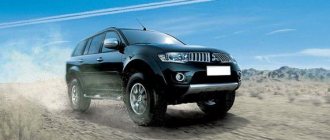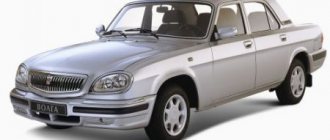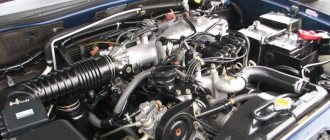Share
Mitsubishi Pajero 2 is the second generation of cars in this series, produced from 1991 to 1999. In 1997, the SUV was seriously modernized. Multiple victories at the famous Paris-Dakkar rally are the calling card of this car. In addition to Japan, cars were assembled in India and the Philippines. Here the jeep was produced for another two years after the Japanese factories switched to the third model.
Pajero 2 was produced in two main versions: with three and five doors. The three-door, five-seater car had a shortened base and a metal or canvas roof (Canvas Top version). The five-door version with a long base had 5 or 7 seats (with an additional row of seats), and was available with a regular (Mid Roof) or high roof (Kick Up Roof).
The technical characteristics of Pajero 2 are different and depend on the modification. Only the width and ground clearance remain unchanged.
| Length | 4030-4705 |
| Width | 1695 |
| Height | 1850 or 1875 |
| Wheelbase | 2420 or 2725 |
| Clearance | 210 |
The curb weight of Pajero 2 is in the range of 1665 - 2170 kg (depending on the model configuration).
Exterior
Even now, more than 20 years after the start of production, Pajero 2 looks quite modern, the body shape is typical for an SUV. The large windshield provides excellent visibility from the driver's seat.
Pajero 2 Mitsubishi
The exterior of the Pajero 2 is traditional for all Mitsubishi, but has its own characteristics. So, after the 1997 restyling, the shape of the wings changed (they became barrel-shaped). Depending on the modification, the color and body kit of the car differ. Even the basic version has fog lights in the bumper.
Interior
The body of the second generation Pajero is larger than that of its predecessor, and the interior space has accordingly increased. The interior is spacious and looks attractive even now. Unfortunately, the three-door body has a small trunk volume. However, it can be increased by folding the rear seats. The five-door version of Pajero 2 does not have this problem.
Salon 2 Mitsubishi Pajero
The instrument panel of the Mitsubishi Pajero 2 is rounded, with clearly visible indicators. In addition to the main instruments, the top versions have an altimeter, an inclinometer and a thermometer that shows the temperature outside. They are located under a separate visor to the right of the main panel. In city conditions, these devices are not very necessary; they are useful when traveling in the desert or mountainous areas.
The Pajero 2 interior has comfortable seats, the backrests are adjustable in the lumbar area. The lighting is perfectly organized. There are two independent heaters; the rear heater can be adjusted by the passengers themselves. All windows and the sunroof are electrically operated.
Video: test comparison of two Mitsubishi Pajero 2
Engines
At the beginning of production, the Mitsubishi Pajero 2 was equipped with a 6G72 gasoline engine or a 4D56T diesel engine. At the same time, cheaper cars were produced with the gasoline 4G54, inherited from the first model. In 1993, they began installing gasoline 6G74 and diesel 4M40. At the same time, vehicles with the modernized 6G72 were produced.
Mitsubishi Pajero 92
In 1997, the 6G74 DOHC MPI was replaced by DOHC GDI. In 1998, the engines were simplified; instead of two camshafts (DOHC), one was installed in the cylinder head (SOHC circuit). Some models also used other Pajero engines .
Below are the acceleration and consumption characteristics of Pajero 2.
| Engine | Acceleration time to 100 km/h, sec. | Average fuel consumption per 100 km, liters |
| Gasoline 99 hp 4G54 2.5 l | ||
| Gasoline 115 hp 4G64 2.3 l | ||
| Gasoline 225 hp 6G72 3 l | 12,5 | 13,7 |
| Gasoline 220 hp 6G74 3.5 l | 10 | 18 |
| Petrol 245 hp 6G74 GDI 3.5 l | 9,9 | 14 |
| Diesel 105 hp 4D56T 2.4 l | 21,5 | 13 |
| Diesel 125 hp 4M40 2.8 l | 16,8 | 15,5 |
About engines for Mitsubishi Pajero
The flagship Mitsubishi Pajero stands above the Mitsubishi Outlander in the company's lineup and competes with Land Rover Discovery, Mercedes-Benz G-Class, Toyota Land Cruiser Prado and many others.
The power support of the popular model mainly consists of diesel engines, but you can also find gasoline units with a volume of 2.5 to 3.0 liters, as well as classic V-6s, under the hood.
Engine Mitsubishi 4G64 2.4 l
The volumetric 2.4-liter 4G64 entered the Sirius family and received the base from the 2.0-liter version 4G63. In the new model, the height of the cast-iron cylinder block was changed, the piston stroke was increased and the cylinder diameter was expanded.
Initially, the aluminum cylinder head had an 8-valve with a single shaft, then it was replaced with a 16-valve with a single camshaft, and later two camshafts appeared.
All modifications of the Mitsubishi 4G64 engine are equipped with hydraulic compensators, which eliminates the need for the driver to adjust valve clearances, but the service life of the gyro compensators is about 50 thousand kilometers.
The timing belt drive needs to be changed after every 90 thousand kilometers.
The problem areas identified are the balancing shafts, which sometimes lack lubrication.
Engine vibrations were also noted due to problematic injectors, temperature sensors, a clogged throttle valve and idle regulator. 4+
Engine Mitsubishi 6G72 3.0 l
In 1986, Mitsubishi introduced the 6G7 family of six-cylinder engines: the 2.0-liter 6G71 and 3.0-liter 6G72. The cylinder block of the latter received a V-shape with a camber angle of 60 degrees.
The aluminum cylinder head has 12 SOHC 12V valves and hydraulic compensators, eliminating the need to adjust valve clearances.
Later, a 24-valve cylinder head with a single camshaft was installed on the 6G72 engine, which increased performance to 185 hp.
The main disadvantages of the engine include high oil consumption due to imperfect oil scraper rings and caps.
Engine knocking is associated with hydraulic compensators or rotation of valve liners, which threatens major repairs.
The problem of floating speed is most often associated with the idle regulator or the throttle valve may need to be cleaned.
Also, the 6G72 engine requires replacing spark plugs every 100 thousand kilometers, which requires removing the intake manifold. 5-
Engine Mitsubishi 6G74 3.5 l
The 6G74 powerplant was a larger version of the Cyclone V6 family and appeared in 1992.
Engineers modified the cylinder block for the crankshaft with a large piston stroke. And the cylinder diameter was expanded to 93 mm. All cylinder head modifications received hydraulic compensators. One of the simplest SOHC 24V with a compression ratio of 9.5 and a power of 180-222 hp. used on engine heads for Pajero Sport, Pajero 2/3/4 and others.
Based on a 280 hp engine. and a DOHC cylinder head with a compression ratio of 10 was developed by Mitsubishi Pajero Evolution.
The timing belt drive requires replacement every 90 thousand kilometers.
The disadvantages of the 3.5-liter Mitsubishi 6G74 are the same as those of its smaller brother Mitsubishi 6G72: oil consumption, knocking, floating speed. In addition, problems with GDI often arise. 4
Engine Mitsubishi 6G75 3.8 l
The largest engine in the series, the Cyclone V6 6G75 3.8 liter, appeared in 2003 and was installed on the Mitsubishi Pajero 3. The new engine differed from its 3.5 liter predecessor by a 22 mm higher cylinder block with a crankshaft with a piston stroke of 90 mm and an expanded cylinder diameter. The connecting rods became forged.
The single-shaft cylinder head received an IFGR system and MIVEC valve lift.
The timing belt uses a belt that requires replacement every 90 thousand kilometers, along with replacing the roller and pump.
The disadvantages of the 6G75 are similar to all the disadvantages of the Cyclone V6 series and increased oil consumption, knocking and floating speeds have not gone away. 4
Source
Transmission
The Mitsubishi Pajero 2 was equipped with a unique transmission. It has become possible to switch the drive while driving, although this causes the gears to wear out faster.
Mitsubishi Pajero 2 automatic
The Pajero 2 driver can choose one of the options:
- 2H – the most economical mode with the rear axle connected;
- 4H - both axles are turned on, which is recommended when driving on slippery roads;
- 4HLc – all-wheel drive with center differential lock;
- 4LLc - the same, but in a lower gear;
- N – neutral position (available only on cars with manual transmission).
Today the Super Select 4WD is used on many brands of cars, but in those years it was a new product developed by the concern’s engineers specifically for the Pajero 2.
The car was equipped with a manual transmission with five gears or an automatic transmission with four. The latter had 3 operating modes:
- Normal – normal;
- Power – reinforced, for faster acceleration;
- Hold – for driving on roads covered with snow or ice.
On slippery roads, it is recommended to start in second gear. Pajero 2 gear shifting is spread out over time, which also reduces the risk of skidding.
The second Pajero was equipped with 2 types of automatic transmissions. These are V4AW2 03-72L and V4AW3 30-43LE. Let's take a closer look at them.
- V4AW2 03-72L is equipped with or without torque converter lockup. This is a solid hydromechanical design, the only electrical components are the fourth gear valve with a switching circuit. Such machines were installed on modifications with 4D56 and 12-valve 6G engines
- V4AW3 30-43LE fully electronic automatic transmission. The ECU is connected to the automatic transmission separately, there are many sensors that transmit information. Such boxes were equipped with modifications of Pajero 2, equipped with 4M40, 24-valve 6G72 and 6G74 (single-shaft/double-shaft) engines.
Modifications with 6G74 GDI are equipped with a different gearbox - a 5-speed tiptronic. Also, some versions with 4M40-EFI were equipped with electronic 4-speed V4A51 automatic transmissions, like on the Pajero Sport.
to fill the Pajero 2 automatic transmission with Dia Quenn ATF SP or ATF DEXRON 2. It is advisable to fill the V4A51 gearbox with Dia ATF SP3 or an alternative oil.
To ensure an economical trip on the highway, it is recommended to engage overdrive or high gear. On a 4-speed automatic transmission of Pajero 2, this gear is equivalent to fifth speed. Overdrive should be turned off when overtaking, when the SUV speed exceeds 100 km/h. After completing the maneuver, the mode must be turned on again.
The overdrive function is activated by pressing the OD OFF button on the Pajero 2 automatic transmission selector
Mitsubishi Pajero Sport
The Mitsubishi Pajero Sport has been produced since 1996, in Japan it is called Challenger, and in the USA it is sold under the Montero brand. In total, as of 2021, there are three generations of the SUV - the Pajero Sport-1 model was produced until 2010, its platform is the Mitsubishi Pajero-2. The SUV in the Sport version has almost the same suspension as the base car, but differs in design, smaller size, and is more endowed with sporting qualities. The car was restyled more than once; in 2000, the springs on the rear axle were replaced with springs.
The debut of the second generation Pajero Sport (based on Mitsubishi Triton) took place in the fall of 2008, the car was presented at the Moscow Motor Show. This SUV is available in both 5-seater and 7-seater versions; the main production of the brand was established in Thailand. "Sport-2" was produced until 2021.
Since August 2015, in the same Thailand (Laem Chabang), the assembly of Pajero Sport -3 has been established; the well-known L-200 pickup truck is taken as the basis for the new brand. Also, the new model will be produced in Indonesia; production of the car is planned to begin in April 2017.
Advantages and disadvantages
Many Mitsubishi Pajero 2 owners post reviews online describing the pros and cons of the model. The advantages include:
- high reliability and durability;
- ease of control;
- excellent cross-country ability in off-road conditions;
- spacious and comfortable interior;
- good sound insulation;
- precise operation of transmission mechanisms;
- good visibility from the driver's seat.
Some disadvantages of Pajero 2 are indicated:
- high fuel consumption, especially for gasoline engines;
- there is no steering wheel height adjustment;
- insufficient efficiency of the on-board computer.
Most of the complaints are about the “gluttony” of the Pajero 2 model. But there are also objective reviews that indicate that it is difficult to expect efficiency from an SUV weighing about 2 tons. It was also noted that the Mitsubishi Pajero 2 manual transmission cushions tear over time, but this is a working situation.
Used Mitsubishi Pajero 2: “good” and “bad” engines and gearboxes
Transfers and locks
This is one of the most important parts of this machine and at the same time one of the most expensive to repair.
Even with a completely acceptable service life of cardan shafts and gearboxes, there are still plenty of problems. I already talked about the rear axle in the first part; this is a very expensive unit that is easily damaged by careless off-road driving. What about transfer cases? They are divided into “full” Super Select and “simply” 4WD, that is, hard-wired part-time. Each transfer case is available in two versions, “large” and “small”, for the corresponding gearboxes and rear axles.
The “part-time” 4WD, which is simpler in design, however, is not absolutely glitch-free, because here the connection of the front axle axle is controlled by pneumatics (excluding rare budget purely mechanical versions). The system is not very complicated: vacuum from a vacuum pump (on diesel engines) or from a manifold through a vacuum tank and a pair of actuators is supplied to the actuator. Everything is managed by a pair of sensors and a control unit. However, there are plenty of glitches on older machines. If the all-wheel drive light flashes while driving, it always means something is going wrong.
Pictured: Mitsubishi Pajero Metal Top '1991–97
Superselect's device is more complex, there are many more sensors and actuators. It also has a center differential, which means that in addition to modes with rear axle drive, simple and reduced all-wheel drive, it can also perform permanent all-wheel drive with center locking.
Articles / Used cars Mitsubishi Pajero 2 with mileage: frame corrosion and “killable” suspension More than 25 years have passed since it entered the market, but the second generation Pajero was produced in some countries right up to 2012, the design turned out to be very durable, so cars on... 23737 1 11 10/11/2016
Standard problems with all distributors of older cars are stretched chains, damage to bearings and oil leaks. Plus, on all Pajero transfer cases, the sensors of the all-wheel drive system cause a lot of trouble.
In addition to controlling rows and locks in transfer cases, the Pajero can also control rear axle locks, which... yes, you guessed it, exist in several versions. There is a basic version without any locking at all, there is an “automatic” version with an LSD viscous clutch, and there is also a rigid pneumatic one. Naturally, the life of the viscous coupling is finite, and the pneumatics are simply glitchy, so the effectiveness of the blocking decreases with age.
All systems should be checked when purchasing: if the car seems to be driving, but something is blinking on the dashboard or doesn’t connect right away, then the cost of restoration can be absurdly high. After all, you don’t need a Jeep without all-wheel drive, do you?
Mechanical boxes
Not everything is so simple with them either. The “mechanics” of the V5M31 series is definitely considered reliable; it is combined with a “large”, more durable transfer case and its problems mainly come down to oil loss and wear of the second and third gear synchronizers. It was used regularly with 2.8 and 3.5 engines, but it is also found with a 3.0 engine on restyled cars. The V5MT1 series manual transmission is a little weaker, more prone to oil leaks, sometimes loses synchronizers and clutches in frequently used gears, but rarely breaks down completely.
Pictured: Mitsubishi Pajero Wagon GL '1991–97
Used with 2.5 and 3.0 engines before and after restyling. Older machines may have problems with bearings and shafts, but this is more likely a consequence of oil loss or water ingress than a purely resource problem. This box is combined with a “small” transfer case, and with a 3.0 engine its resource may already be too short.
The V5M21 manual transmission is only available with 2.4 and 2.6 four-cylinder petrol engines, and it cannot withstand even their low power. Damage to bearings and shafts is common, but cars with these engines are generally rare and their age is usually maximum. It can only be combined with a “small” transfer case, which is in no danger with such engines.
Pictured: Mitsubishi Pajero Metal Top '1991–97
Automatic boxes
Probably, there is no need to say that there are a lot of automatic transmission variations on the Pajero?
The four-speed Aisin AW03-72L can be found mainly on the simplest modifications of the Pajero II Wagon with a 2.4 engine until 1994, as well as on the American Montero II, even with V6 3.0 engines, which are clearly redundant for it.
Pictured: Mitsubishi Pajero Wagon '1997–99
The automatic transmission is well known from Toyotas - it was installed on Hulux pickups with 2.0–2.7 engines, as well as Cresta/Mark II/Chaser, Crown cars and many other models with engines of similar size. And she proved herself to be excellent. If you don’t forget to change the oil and don’t overheat, it can go several hundred thousand kilometers. The resource limitation is mainly due to wear of the clutches, less often due to loss of pressure by the pistons or valve body seals. It rarely gets dirty even with a “standard” oil change interval of every 60 thousand, since the gas turbine engine blocking rarely works and wears out little.
On the Pajero, water is also added to its enemies - when overcoming fords, water may enter the ATF, and if you do not immediately clean the oil system, the emulsion will quickly kill the cardboard clutches.
Rear cardan shaft
price for original
55,362 rubles
The automatic transmission of the Aisin AE30-43/AW30-70LE series is no less reliable. These boxes are perhaps more reliable than the machines themselves. They were installed with all engines before 2006, and this is a truly excellent “automatic”. Boxes were also used on Toyotas and Lexuses, in particular on the GS430, LX470, Cressida, the same Crown, Mark II and others. Failure, again, most likely, after an unrealistic mileage or serious overheating. It is extremely difficult to disable it in any other way; it can withstand loads more serious than even a 3.5 engine can create.
Automatic transmissions developed by Mitsubishi itself, the V4A51 series, are no longer as reliable as the Aisins of the old series, but still quite strong. It almost always lasts up to a mileage of 200 thousand kilometers; more is no longer a fact. In addition to purely resource limitations, there are also electrical problems with sensors and wiring, and contamination of the valve body. The service life of gas turbine engine blocking linings is large, but hardly more than 250–300 thousand kilometers. They are found mainly with a 2.8 diesel engine and on cars manufactured after 2000 with a 3.5 engine assembled in India.
The five-speed V5A51 is made on the basis of a four-speed gearbox and is also a development of Mitsubishi itself; in terms of reliability it is not much inferior to its predecessor, but the car with it is noticeably more economical. It was used mainly on cars with 3.5 engines produced after 1998, and after the cessation of production of Pajero II in Japan - on regionally assembled cars with all engines.
Gasoline engines
Articles / Used cars Choosing a used Mitsubishi Pajero Sport I: reliable and unreliable engines and transmissions The first generation Mitsubishi Pajero Sport was produced for 11 years and, against the background of more modern “simply Pajero” of the same years, was sold as a simplified version based on the L200 pickup truck for harsh conditions . K... 48513 7 4 09.14.2016
The engines on the Pajero II are mostly already familiar to those who have read the Pajero Sport review . But in addition to the gasoline 2.4 series 4G64, 3.0 6G72, 3.5 6G74 and diesel 2.5 4D56, older gasoline engines 2.6 4G54, a new turbodiesel 2.8 series 4M40, as well as several new variants of the 6G74 engine were added .
Gasoline in-line fours on the Pajero II are rare and are mostly the good old 2.4 4G64 in different versions. The power system is always distributed injection, reliability is at the level of one of the best engines of the 4G63 series, in fact, it differs only in cylinder diameter and piston stroke. On a heavy SUV, the power is no longer enough, but nevertheless, the engine can travel several hundred thousand kilometers without serious problems. Unfortunately, cars with this unit are mainly versions before the intermediate restyling of ’94. This means that they are the oldest, worn out and with spring rear suspension, that is, not the best option in principle.
The extremely rare 2.6 4G54 engine is most often found in a carburetor version on cars from 1990–1992, and after that, sometimes in a version with distributed injection. It is considered phenomenally reliable and indestructible, but, alas, it will not be possible to test it. This is a real rarity, almost a legend, because it was on this engine that Mitsubishi first tested the combination of electronic injection and turbocharging, although in this version it was not installed on the Pajero II.
Pictured: Mitsubishi Pajero Metal Top '1991–97
The title of the most common engines is held by the V6 3.0 series 6G72 in two forms: before 1997 - the SOHC version with 12 valves and after - also SOHC, but with 24 valves. The power and ignition systems also differ. 12-valve engines have an ignition system with a coil and distributor, while 24-valve engines have a more traditional ignition module.
The motors are extremely reliable, the block is cast iron, the piston group is moderately conservative. The timing belt is driven by a thick and high-quality belt. On older engines, problems are often associated with gradual coking of the piston group due to oil leaks through valve seals, because the crankcase ventilation system is far from perfect and requires regular maintenance.
The control system on both 12- and 24-valve engines is not without fault, but is quite reliable. Failure of lambda sensors and intake leaks are its main problems, which subsequently lead to the destruction of catalysts. Which in turn can lead to accelerated wear of the piston group.
If you keep the oil level at the upper limit, then the second drawback in the form of vulnerability of the crankshaft due to oil starvation is also not a problem, but for off-road driving it is recommended to even exceed the maximum level by another liter.
Pictured: Mitsubishi Pajero Metal Top '1991–97
Articles / Practice The imperfection of spontaneity: reliability and problems of engines with direct injection “Into the new century - with a new power system!” It seems that European manufacturers began to implement the technology with this motto. What was left for them? Requirements to reduce fuel consumption forced... 59221 0 16 06/02/2016
Problems with the crankshaft pulley also occur: unfortunately, when the key is not carefully tightened and the old sprocket is used in the timing drive, the key is cut off, and the drive pulley for additional units rotates on the shaft. To prevent such troubles, it is recommended to replace the pulley mounting bolt with a new one every time the belt is replaced, and the crankshaft sprocket at the slightest looseness. By the way, do not count on 120 thousand kilometers of belt service life; in our conditions it is recommended to change it once every 60–90 thousand maximum, including replacing all the rollers, checking the operation of the hydraulic tensioner and replacing the front cover seals.
The engine cooling system was initially rather weak, and over the years its capabilities have not improved. Radiators clog easily, especially on versions with air conditioning, where the “sandwich” of radiators becomes dirty not only from the outside, but also from the inside. The lifespan of the pump is very modest, and the reliability of the hoses is also questionable. And the viscous coupling with the fan is also far from eternal, the fan simply loses its blades, the viscous coupling not only jams, but sometimes begins to slip due to loss of oil.
More powerful engines of the 3.5 6G74 series initially have an ignition system with a module, without a distributor, otherwise similar to the 6G72 series. After 1997, you can also find a DOHC version of this engine with a power of over 200 hp. s., and the MIVEC version with phase regulators was installed on the Evolution version. On late-production Japanese cars you can even find a GDI version of the engine, which is equipped with first-generation direct injection and which should be avoided due to its damp design .
Diesel engines
Diesels are represented mainly by the older 2.5 series 4D56 engine, which is considered not the most successful Mitsubishi unit, and the more recent 4M40 series engine from commercial vehicles, with a volume of 2.8 liters. The latter turned out to be noticeably more reliable, but, unfortunately, more expensive to restore.
The 2.5 4D56 engine has already appeared in the story about Pajero Sport , but I will repeat it here. The design, tested over the years, turned out to be not suitable for increasing power. 99 l version. With. can still be considered relatively strong, but more and more powerful versions receive a lot of damage under prolonged load: cracks in the cylinder head and cylinder block, broken camshafts, burnouts of the cylinders...
Radiator
price for original
48,460 rubles
Even the timing belt on the 2.5 diesel engine has an unstable service life; it often breaks during a “children’s” mileage of 30–40 thousand kilometers due to problems with camshaft lubrication and rocker failures. Fuel equipment before 1994 was considered frankly unreliable, after that it was noticeably better, but not ideal. In general, this is the case when you can say an unequivocal “no” with a clear conscience.
After 1994, another engine appeared for the Pajero II, this is the 2.8-liter 4M40 engine. This series of diesel engines, unlike the very old 4D56, has a seriously reinforced design, and a fairly reliable chain is used in the timing drive. The engine easily handles the conditions in which the good old 4D56 gave up - prolonged driving at high speed and prolonged full load when driving uphill and with a trailer. If you need a diesel engine, then you already know what volume it will be.
Pictured: Mitsubishi Pajero Metal Top '1991–97
What's the result?
The main conclusion that a potential buyer of the Mitsubishi Pajero 2 should make for himself is that you should not rely on an archaic design that will ensure a trouble-free 20-year service life. Pajero rot easily and often break if you don't take care of them. Therefore, diagnostics must be comprehensive and thorough, checking the machine’s performance in all modes, including “ground”.
As for the optimal modification, everything is not obvious. The most durable versions are with the most powerful engines, petrol 3.5 and diesel 2.8. Some manual transmissions turn out to be less reliable than automatic transmissions. Superselect is predictably more expensive than “part time” to operate, but will provide more freedom of action. For moderate operation “city-dacha-forest on holidays” the “petrol 3.0 with automatic transmission” option is quite suitable.
Survey
Would you buy a Mitsubishi Pajero 2?
Your voice
Total votes:
Recommendations for buyers
Those who want to purchase a Mitsubishi Pajero 2 need to consider several points.
- The production of Pajero 2 has been discontinued for a long time, the warranty period has expired, all repairs will have to be done at your own expense. Therefore, you need to carefully check the condition of the car before purchasing. It’s better to go to a technical center and diagnose the main components.
- When choosing a modification, you should understand that driving with an automatic transmission is good only in cities with heavy traffic and frequent traffic jams. On the highway, a car with a manual transmission is more economical; it is also better suited for off-road use.
- Cars with a diesel engine are more economical, but require good quality fuel, which is not always available, especially away from big cities.
If you need a reliable work machine that can drive in difficult places, then the Mitsubishi Pajero 2 is quite suitable. You just need to find a used car in good condition. This is real, because for careful owners, a car with a mileage of 600-700 thousand km looks quite decent.










